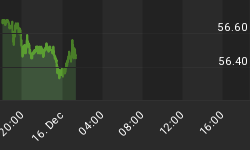The gold standard that was in place until 1971 prevented unchecked federal deficit spending, and excessive borrowing to consume foreign goods. With the gold standard in place, if the US were to accumulate large foreign debts, foreigners could exchange their Dollars for the United States' gold, gold reserves would diminish, the Dollar would fall in value, and interest rates would rise until the US could attract capital. Higher interest rates and diminished purchasing power would force the US to save more and spend less, which would rebalance the economy. Today, even though the US is no longer on the gold standard, foreign central banks have created a new gold window by using their Dollar reserves to buy gold on the open market.
President Nixon closed the gold window because the United States' creditors were rapidly exchanging their Dollars for gold. The ending of the gold standard resulted in a loss of confidence in the Dollar, which led to the very high inflation of the 1970s. Although confidence in the Dollar should have continued to decline in the 1980s and 1990s as the Dollar remained unconvertible to gold and the US current account deficit increased exponentially, it instead rose sharply. Strong confidence in the Dollar was demonstrated by the willingness of the United States' creditors, such as China, to accumulate Dollars even as the growing trade deficit meant that creditors were accumulating more Dollars than they could ever sell.
For years, the United States' foreign creditors accumulated Dollars in exchange for their manufacturing production and natural resources. This relationship allowed the Dollar to remain the world's reserve currency. However, this relationship is changing because our creditors are converting their Dollars to gold. China, India, Sri Lanka, and Russia, as well as other countries, have increased or plan to increase their gold holdings. Historically, currency crises ensued when foreigners no longer wanted to hold a currency and instead demanded gold. Perhaps, investors remain complacent because they see no ramifications from the falling Dollar since US gold reserves will not be depleted. Yet, in effect, central banks have replicated the gold window by selling their Dollars on the open market. If this trend continues, a currency crisis will lead to rising long-term interest rates and falling assets prices.
In addition to the "reopening" of the gold window, the buying of gold by developing countries demonstrates that a historic transfer of wealth is underway. For years the developed world has borrowed money from the developing world to enable its consumption of the developing world's production and natural resources. While the developed world accumulated debt, the developing world accumulated foreign exchange reserves (savings). As foreigners sell their Dollars to buy assets and natural resources, the transfer of wealth from the developed world to the developing world will accelerate. Accordingly, Americans will suffer from higher costs and a lower standard of living; the rest of the world's standard of living will improve.
Investors and central banks accumulated US Treasury bonds and Dollars at an increasing rate since the 1980s despite reckless US monetary and fiscal policy and the Dollar no longer being backed by gold. Even though it should have been clear that Dollars were being irrationally hoarded, the Dollar remained overvalued and over owned. The period of misplaced confidence in the Dollar has come to an end. Central banks are now using their Dollars to buy gold and will continue to use the open market as an alternative to the gold window. The days of the Dollar as a reserve currency are over and a currency crisis is already underway.
















